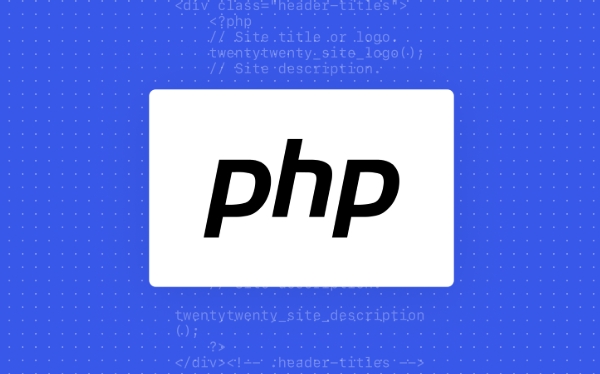The reason why the table name cannot be bound with parameters is that preprocessing parameters can only be used for the location of the value, and the table name belongs to the SQL structure part. 1. Whitelist verification: limit the range of optional table names; 2. Use backticks to wrap table names to avoid keyword conflicts; 3. Map table names from within the program instead of directly using user input; 4. Always verify input and record exception access to ensure security.

When executing SQL queries with PHP preprocessing statements, it is usually recommended to pass variables into the form of parameter binding to prevent SQL injection. But if you need to dynamically specify the table name, things get a little different.

Because the preprocessing mechanism of PDO or MySQLi does not allow the table name to be bound directly as a parameter, that is, you cannot write like this:
$stmt = $pdo->prepare("SELECT * FROM ?");
$stmt->execute([$table_name]);This will report an error or the table name cannot be parsed correctly. What should I do? Here are some practical ideas and practices available.

Why can't we bind table names with parameters?
SQL preprocessing parameters ( ? or :name ) can only be used for the position of values , such as strings, numbers, dates, etc. The table name is part of the SQL statement structure, not a "value".
For example:

SELECT * FROM users WHERE id = ?
Here ? is a value that can be safely bound; but if you write this:
SELECT * FROM ? WHERE id = ?
The first ? represents the table name. If the database does not know how to parse it, an error will occur.
How to use variable table names safely?
Since you cannot directly bind the table name, you can only manually splice SQL statements. But to prevent SQL injection, you need additional verification or filtering.
Common practices are:
- Whitelist verification: Only certain specific table names are allowed to appear.
- Use backticks to wrap table names (used in MySQL)
- Instead of using the original data entered by the user, mapped from within the program
For example:
$allowed_tables = ['users', 'orders', 'products'];
$table_name = $_GET['table'];
if (!in_array($table_name, $allowed_tables)) {
die('Invalid table name');
}
$sql = "SELECT * FROM `$table_name` WHERE id = ?";
$stmt = $pdo->prepare($sql);
$stmt->execute([1]);The key to doing this is to control the input source, rather than being completely open to users to fill in freely.
What should I pay attention to in practical applications?
In actual development, although there are not many scenarios for using variable table names, they do exist, such as multi-tenant systems, dynamic query tools, CMS modules, etc.
A few things to note:
- Don't trust user input : even in the background management interface, check it.
- Try to avoid letting users directly enter table names : you can use drop-down boxes or options instead.
- Use backticks to wrap table names : prevent errors when table names are keywords, such as
orderis MySQL keywords. - Record logs and monitor abnormal inputs : Once illegal access is found, intercept it in time.
summary
PHP's preprocessing statements do not support direct binding of table names, which is due to SQL syntax design. If you really need to use variable table names, you can do this by checking backtick wrapping by whitelisting while maintaining security.
Basically all this is it. Although it has taken a turn, as long as the logic is clear, it can still be done cleanly and safely.
The above is the detailed content of PHP prepared statement with variable table name. For more information, please follow other related articles on the PHP Chinese website!

Hot AI Tools

Undress AI Tool
Undress images for free

Undresser.AI Undress
AI-powered app for creating realistic nude photos

AI Clothes Remover
Online AI tool for removing clothes from photos.

Clothoff.io
AI clothes remover

Video Face Swap
Swap faces in any video effortlessly with our completely free AI face swap tool!

Hot Article

Hot Tools

Notepad++7.3.1
Easy-to-use and free code editor

SublimeText3 Chinese version
Chinese version, very easy to use

Zend Studio 13.0.1
Powerful PHP integrated development environment

Dreamweaver CS6
Visual web development tools

SublimeText3 Mac version
God-level code editing software (SublimeText3)

Hot Topics
 What are some best practices for versioning a PHP-based API?
Jun 14, 2025 am 12:27 AM
What are some best practices for versioning a PHP-based API?
Jun 14, 2025 am 12:27 AM
ToversionaPHP-basedAPIeffectively,useURL-basedversioningforclarityandeaseofrouting,separateversionedcodetoavoidconflicts,deprecateoldversionswithclearcommunication,andconsidercustomheadersonlywhennecessary.StartbyplacingtheversionintheURL(e.g.,/api/v
 How do I implement authentication and authorization in PHP?
Jun 20, 2025 am 01:03 AM
How do I implement authentication and authorization in PHP?
Jun 20, 2025 am 01:03 AM
TosecurelyhandleauthenticationandauthorizationinPHP,followthesesteps:1.Alwayshashpasswordswithpassword_hash()andverifyusingpassword_verify(),usepreparedstatementstopreventSQLinjection,andstoreuserdatain$_SESSIONafterlogin.2.Implementrole-basedaccessc
 What are weak references (WeakMap) in PHP, and when might they be useful?
Jun 14, 2025 am 12:25 AM
What are weak references (WeakMap) in PHP, and when might they be useful?
Jun 14, 2025 am 12:25 AM
PHPdoesnothaveabuilt-inWeakMapbutoffersWeakReferenceforsimilarfunctionality.1.WeakReferenceallowsholdingreferenceswithoutpreventinggarbagecollection.2.Itisusefulforcaching,eventlisteners,andmetadatawithoutaffectingobjectlifecycles.3.YoucansimulateaWe
 What are the differences between procedural and object-oriented programming paradigms in PHP?
Jun 14, 2025 am 12:25 AM
What are the differences between procedural and object-oriented programming paradigms in PHP?
Jun 14, 2025 am 12:25 AM
Proceduralandobject-orientedprogramming(OOP)inPHPdiffersignificantlyinstructure,reusability,anddatahandling.1.Proceduralprogrammingusesfunctionsorganizedsequentially,suitableforsmallscripts.2.OOPorganizescodeintoclassesandobjects,modelingreal-worlden
 How can you handle file uploads securely in PHP?
Jun 19, 2025 am 01:05 AM
How can you handle file uploads securely in PHP?
Jun 19, 2025 am 01:05 AM
To safely handle file uploads in PHP, the core is to verify file types, rename files, and restrict permissions. 1. Use finfo_file() to check the real MIME type, and only specific types such as image/jpeg are allowed; 2. Use uniqid() to generate random file names and store them in non-Web root directory; 3. Limit file size through php.ini and HTML forms, and set directory permissions to 0755; 4. Use ClamAV to scan malware to enhance security. These steps effectively prevent security vulnerabilities and ensure that the file upload process is safe and reliable.
 How can you interact with NoSQL databases (e.g., MongoDB, Redis) from PHP?
Jun 19, 2025 am 01:07 AM
How can you interact with NoSQL databases (e.g., MongoDB, Redis) from PHP?
Jun 19, 2025 am 01:07 AM
Yes, PHP can interact with NoSQL databases like MongoDB and Redis through specific extensions or libraries. First, use the MongoDBPHP driver (installed through PECL or Composer) to create client instances and operate databases and collections, supporting insertion, query, aggregation and other operations; second, use the Predis library or phpredis extension to connect to Redis, perform key-value settings and acquisitions, and recommend phpredis for high-performance scenarios, while Predis is convenient for rapid deployment; both are suitable for production environments and are well-documented.
 What are the differences between == (loose comparison) and === (strict comparison) in PHP?
Jun 19, 2025 am 01:07 AM
What are the differences between == (loose comparison) and === (strict comparison) in PHP?
Jun 19, 2025 am 01:07 AM
In PHP, the main difference between == and == is the strictness of type checking. ==Type conversion will be performed before comparison, for example, 5=="5" returns true, and ===Request that the value and type are the same before true will be returned, for example, 5==="5" returns false. In usage scenarios, === is more secure and should be used first, and == is only used when type conversion is required.
 How do I perform arithmetic operations in PHP ( , -, *, /, %)?
Jun 19, 2025 pm 05:13 PM
How do I perform arithmetic operations in PHP ( , -, *, /, %)?
Jun 19, 2025 pm 05:13 PM
The methods of using basic mathematical operations in PHP are as follows: 1. Addition signs support integers and floating-point numbers, and can also be used for variables. String numbers will be automatically converted but not recommended to dependencies; 2. Subtraction signs use - signs, variables are the same, and type conversion is also applicable; 3. Multiplication signs use * signs, which are suitable for numbers and similar strings; 4. Division uses / signs, which need to avoid dividing by zero, and note that the result may be floating-point numbers; 5. Taking the modulus signs can be used to judge odd and even numbers, and when processing negative numbers, the remainder signs are consistent with the dividend. The key to using these operators correctly is to ensure that the data types are clear and the boundary situation is handled well.






